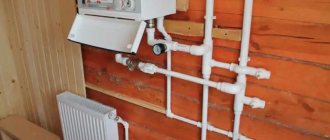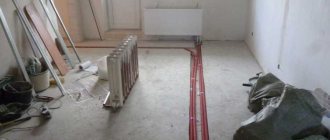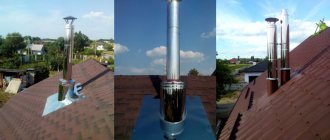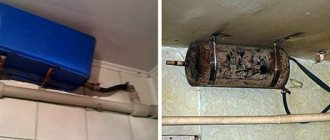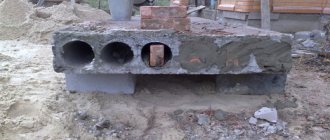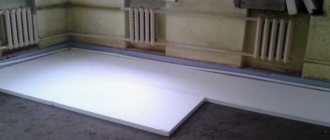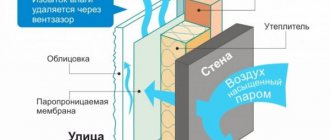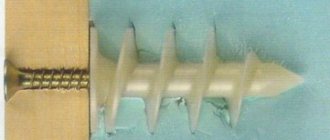General information about electric boilers
Thermal power units of this category are attractive due to their high efficiency and ease of operation, which is why they are especially popular among consumers. Manufacturers of electric boilers offer the following types of equipment:
- Heating element electric boilers. The operation of the heating device is ensured by a heating element in the heat exchanger. The device is distinguished by its ease of installation and connection, ease of use.
- Electrode devices. The coolant warms up as electricity passes through water and salts. The application of current causes the movement of water particles, their energy is converted into heat. Electrodes dissolve in the working environment over time, so periodic replacement of elements is required.
- Induction heating boilers. The heat exchanger is a dielectric tube with a ferromagnetic rod.
When the latter device operates, eddy currents arise and thermal energy is generated.
Installation of a gas boiler
It is important that all work with gas should be performed only by certified specialists; all you have to do is connect the equipment.
Do-it-yourself installation of gas boilers requires special care. Most actions are prohibited from being done independently.
To install a wall-mounted boiler with your own hands, you will need to perform a number of steps:
- In a specially designated place, secure the mounting strips at a distance of 1.5 meters from each other.
- Hang the boiler on them.
- Install a filter into the pipe intended for water supply. This will prevent dirt and scale from getting into the heat exchanger.
- Install the chimney pipe and check the draft. Monitor the process and eliminate the possibility of reverse draft.
- Connect the boiler to the pipeline using a threaded coupling. Don't do this yourself!
- The connection must be made by a gas service worker, he will check the correct installation of the boiler, start it up and put it into operation.
Advantages and disadvantages of using electric boilers
The competitive advantage of installing an electric boiler in a private home is considered to be a high level of operating comfort at a minimum cost. Also among the advantages of power equipment, the following points are noted:
- high level of efficiency, relatively compact size, ease of operation;
- wide power range. It is easy to choose a model of optimal performance for heating areas of various sizes;
- no permit is required to install the structure;
- safety of operation, ease of installation and maintenance;
- environmental friendliness of the equipment.
Electric boilers have a high level of efficiency.
In addition, models of electric heating boilers are presented in an affordable price segment.
The big disadvantage of using electric thermal power units is the significant level of electricity consumption. To mitigate the problem, you can install boiler equipment connected to a buffer tank. In addition to the high cost of consumed energy resources, the need for grounding and the risk of electric shock are also among the disadvantages of the devices.
Installation rules and features
To install an electric heating boiler with your own hands, you must carefully study the instructions that come with the product. Installation involves several stages:
- preparation of the installation site and installation of fasteners. The surface on which the thermal power unit is installed must be finished with a fire-resistant panel. To prevent distortions, the brackets are adjusted using a construction level;
- grounding For electrical safety purposes, the electric boiler installation diagram provides for connecting the power device to the grounding bus. Copper wire with a cross section of 4 mm is used. The conductor is connected to the neutral terminal at the bottom of the housing;
- install a circulation pump and an expansion tank if they are not provided for in the design of the heating boiler.
During commissioning, special attention is paid to such points as the tightness of the entire system and the removal of excess air. Next, the equipment is tested in various operating modes.
Electric boiler installation
Such models have a number of advantages; they do not require installing a chimney, purchasing fuel or installing ventilation. The only but significant disadvantage of such units is the high cost of electricity.
Installation of such models is quite simple. Therefore, we bring to your attention a video of installing a boiler with your own hands. When viewing, you can get acquainted with all the nuances.
Pay special attention to how to properly tie the boiler. This is a very important element.
Electric heating boiler wiring
Electric boiler wiring includes the following elements:
- circulation pump - the device is designed to ensure the movement of coolant along the circuit to transfer thermal energy to heating devices;
- expansion tank - the design is designed to receive excess coolant when it overheats excessively;
- safety valve - the functionality is activated exclusively in emergency situations, for example, when the working medium boils when the pump stops or the tank overflows. The action of this piping element involves the discharge of excess coolant into the sewer system;
- automatic air vent - its task is to independently remove air from the circuit. The absence of a device may impede the circulation of the working fluid in the system;
- pressure gauge - designed to monitor the pressure level in the circuit; a device with a value of 4 bar is used.
Installation of an electric boiler
According to the regulations, the installation of an electric heating boiler is necessarily accompanied by the installation of a safety group.
Selecting a location and installation recommendations
The regulatory documents do not provide for restrictions on the installation location of an electric heating boiler. In this case, it is necessary to be guided by the rules for using electrical installations, which indicate restrictions on the placement of high-power power equipment.
Recommendations for installing an electric heating boiler in a private house:
- To limit access to power equipment for the safety of residents, it is worth installing the unit in an isolated space, for example, in a garage or other technical room. This is especially true for combined models of high-power underfloor heating systems.
- New models of boiler equipment with compact configurations can be placed in the kitchen or entrance area. The difficulty here is that you will have to connect a powerful power cable and a heating system main to the installation site of the electric boiler. This is accompanied by additional costs for communications; it is also necessary to organize decoration work to hide engineering structures.
- When installing an electric heating boiler on a wooden wall or other combustible surface, place a basalt panel or sheet of roofing steel under the adjacent part of the power equipment housing.
- The cable should be laid above the pipeline systems to prevent flooding in case of emergency situations.
- It is necessary to place the structure in a designated place so as to provide comfortable access to the power unit for ease of maintenance.
It is best to install an electric boiler in an isolated space.
You should also pay attention to ensure that the pipes do not load the connecting fittings of the electric boiler with their weight.
How to install a solid fuel boiler - step-by-step diagram
Step 1: Select a location
Such equipment should be placed in a separate room.
Basements or ground floors are most often used as a boiler room. Hot coals from the firebox can fall onto the floor, so the base under the boiler must be perfectly level and non-flammable. A concrete slab is perfect. Be sure to ensure that the body is in a strictly vertical position. Its distortions are unacceptable. You also need to maintain the following distances. There should be more than half a meter between the back surface of the heating unit and the wall. And from the front side of the boiler to other objects and surfaces, a distance of at least 125 cm is maintained. The ceiling height cannot be less than 250 cm, and the volume of the room in which the heating equipment is located must be more than 15 cubic meters. Treat the floor and walls of the boiler room with special fire-fighting agents and take care of a good exhaust system.
The photo shows a room with solid fuel heating equipment
Step 2: Preparing components
The circuit consists of a radiator, a pipe, a circulation pump, an expansion tank and the heating unit itself. The kit also includes a heat accumulator, air and safety valves, a pressure gauge and a thermostat. Be sure to check the serviceability of all elements when purchasing and give preference only to reliable manufacturers.
Step 3: Hardware Installation
We display the unit in the boiler room, adhering to all the above requirements. Pay special attention to the position of the body; it should be positioned strictly horizontally. Therefore, check the prepared area again with a level to see if it is level enough. Then we connect all electric heaters, if any are included in the package. In principle, there is nothing complicated about this, since there is a special place in the boiler itself where the heating element will be located, and next to this element there is a thermostat.
Step 4: Install Piping and Electronics
Connection diagrams for solid fuel boilers assume the presence of pipes. It is best to connect them through shut-off valves. The joints are additionally sealed with flax fibers or special plumbing tape. If we are talking about volatile units, then they, accordingly, should be connected to the network. Don't forget about grounding. Next, we install all the devices responsible for the safe operation of the equipment. This is a thermostat, valves, pressure gauge, draft sensor.
Photo of connection diagram for solid fuel boilers
Step 5: Installation of the chimney
Today it is not at all necessary to lay a chimney out of brick; you can assemble it from special plastic elements. In this case, the diameter of the components is selected depending on the power of the equipment. Therefore, be sure to follow the recommendations given in the operating instructions for the selected boiler. Moreover, this stage is especially important, because the key to high-quality operation of a thermal unit is good traction.
Step 6: Filling the Outline
First, we fill the heating circuit with water so that the pressure is slightly higher than the working pressure, and carefully inspect the entire system, especially the joints. This way you will identify all leaks, if any. Then we carefully check whether the internal elements of the firebox are positioned correctly. These include the ignition valve, grates, fireclay stones and plugs.
Step 7: Connection
If the entire circuit is in order, no leaks are detected, then you need to relieve the pressure to operating pressure, adjust the position of the dampers and begin directly operating the heating device. To do this, add and light the fuel, and after 10 minutes close the damper. As soon as the temperature reaches 80 degrees, set the thermostat to the desired level. All that remains is to add firewood in time and enjoy the comfortable microclimate.
- Author: Mikhail Malofeev
Rate this article:
- 5
- 4
- 3
- 2
- 1
(1 vote, average: 5 out of 5)
Share with your friends!
Features of the location of boiler equipment piping
The regulations strictly oblige the installation of each piping unit in a certain area of the system:
- the safety group is installed behind the heating unit, since on this section of the circuit, when circulation stops, the point of highest pressure of the working medium is observed;
- the circulation pump is located in front of the boiler, at the point of the circuit with the minimum coolant temperature;
- the expansion tank is installed at a distance of twice the pump pressure if it is located before it, but if located after it, the distance should be equal to eight times the pump pressure.
In the latest generation electric boilers, all piping elements are often built into the structure.
Connection diagram development
Depending on the design features and nuances of connecting electric boilers to the heating system, appropriate diagrams are used. Standard power device connection diagrams have been developed for various cases, for example:
- installation of a boiler unit that is not equipped with a pumping system and expansion tank;
- if a piping with a buffer tank is provided;
- if there is a connection to be made with an indirect heating boiler;
- An electric heat generator works in tandem with a TT boiler or gas fuel device.
The dual-circuit device must be connected to the heating and hot water mains.
What does a solid fuel boiler look like now?
This heating device is made mainly of cast iron or heat-resistant steel. Energy is released through the combustion of solid fuel. The materials used are wood, coal, and peat. Modern designs of solid fuel boilers for the home are completely different from the first examples of such boilers. Thanks to the enlarged combustion chamber, it became possible to add a large amount of fuel at once. With today's boilers, you can ensure even 12-hour operation of the equipment without your supervision.
The firewood loading pattern can be vertical or frontal, depending on the design. There are systems with automatic loading. Other similar boilers can be non-volatile, in which the circulation of liquid occurs due to the slope of the pipes, and energy-dependent. The latter will be more economical; in them, water moves through the system under pressure, due to the operation of a special pump. True, in this case, the operation of the equipment depends on the voltage in the network, and the circuit is no longer completely autonomous.
Photo of a solid fuel boiler with automatic loading
Such equipment has a lot of advantages, although it is not without minor disadvantages. Let's look at them all in order. The main advantage is that you can install a solid fuel boiler yourself. Also, unlike gas wiring, you don’t have to run around to different services, wait in queues, obtain the appropriate permits, etc. The next significant advantage is cost-effectiveness.
Compared to a gas solid fuel system, it is 4 times cheaper, and with diesel fuel equipment it is 8 times cheaper. And what can we say about electric boilers, heating a house with them will cost as much as 17 times more than with solid fuel ones.
In the photo - a boiler with a solid fuel system
In addition, such equipment has a long service life, for example, for cast iron boilers it reaches 50 years. Steel units, however, can last you only 20 years, but this is also a lot. Modern devices are equipped with an electronic system, which greatly simplifies control. And don’t forget about maintainability. The operating scheme of such boilers assumes operation without the participation of gas or electricity, so another of their advantages includes partial or complete autonomy.
Now let's talk a little about the cons. Firstly, you will have to put firewood, coal and other fuel into the firebox yourself. It's not difficult, but it will take a little time and effort. Secondly, you will have to constantly monitor the condition of the boiler and, if necessary, clean it of ash formed on the walls and grate.
Connection with heating system
Wall-mounted models of electric boilers with a built-in safety group, which provide for operation in closed-type heating systems with forced circulation, are connected by connecting the supply and return pipelines to the corresponding pipes of the thermal power unit.
An electric boiler with a heating element, which is not equipped with an expansion tank and a pump, is connected according to the following diagram:
- the expansion tank is installed on the direct outlet section of the supply pipeline, after which a shut-off valve with a ball mechanism is inserted;
- the pump and sump can be installed both on the supply and return;
- the make-up pipeline is cut into the return line.
Using a similar scheme, the electrode/induction thermal power unit is connected to a closed-type heating system with a membrane expansion tank.
Installation of a floor-standing gas model
Self-installation of a gas heating boiler into the system must be carried out in accordance with SNiP standards.
The meaning of a separate boiler room
A floor-standing gas-fired boiler requires a separate room with parameters no less than standard. A through hole is made in the door so that air flows penetrate into the boiler room, or a window with a window is installed.
The chimney must be sealed; for greater protection, you can install two pipes, placing one inside the other.
The risk of poisoning from carbon monoxide released during the combustion process in the event of the burner extinguishing is eliminated. The risk of fire is significantly reduced.
Preparing the room
The underfloor gas heating device is placed so that there is easy access in case of repairs, for ongoing maintenance.
The boiler room has a water supply system and a drainage system.
Floor-standing models of heating equipment weigh a lot; a solid base with a fire-resistant coating is required before installation. Concrete screed, ceramic tiles, stone, paving stones are suitable.
Forming the foundation for the boiler
Electrical wiring to the boiler is laid only in a closed type, with the installation of a dedicated distribution panel.
The walls are covered only with non-flammable materials, such as plaster and tiles.
It is prohibited to store flammable objects in the boiler room, or place close to the chimney outlet or ventilation with air intake.
Connection to gas outlet, communications
To remove combustion products, it is recommended to install coaxial-type structures with insulation with non-combustible material between the pipes.
The chimney is secured to the wall with brackets, and the component sections are secured with a lock.
In places where pipes come into contact with the ceiling or roof, the chimney is covered with a non-flammable layer, and waterproofing is used at the point of contact with the roof. Additionally, the junction with the roof is covered with mastic.
Chimney insert
There should be a cap at the top of the chimney to prevent debris and precipitation from getting inside.
When the smoke exhaust structure is ready, begin installing the unit.
Threads are formed on the heating supply pipes, the pipes are connected with nuts and fum tape, which is wound onto the threads before tightening. Use sanitary linen coated with liquid sealant.
Example of a connected boiler
The connection to the gas supply line must only be carried out by a specialist from the gas service. The connection to the highway is left until the very end: the master makes the connection and conducts a test run.
Test run of a gas appliance
An example of connecting a floor-type gas heat generator:
How to organize a connection to an open-type gravity heating network?
The connection of an electric boiler with a gravity heating system is carried out according to the following scheme:
- an open expansion tank is installed at the top point of the network, followed by a shut-off valve;
- pipelines in both directions are laid with a slope of 3 mm/linear meter;
- The circulation pump is placed on the bypass.
Since, to ensure stable gravity flow, a vertical height of 2 meters between the electric boiler and the tank is recommended, the expansion tank is placed in the attic.

